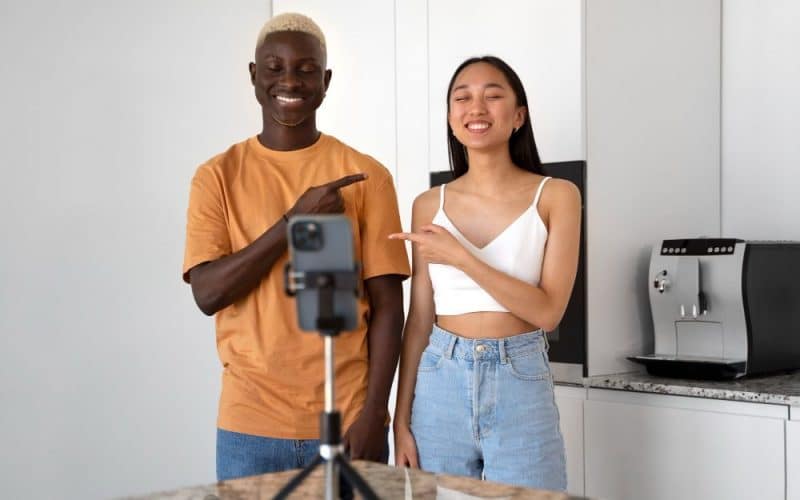YouTube influencers can be a key part of a successful marketing strategy. Not only can they help promote your brand, but they can also increase your audience reach on one of the biggest content platforms out there. But how do you find YouTube influencers?
And, more importantly, how do you find the right influencer that fits your business?
Firstly, it’s important to have a clear idea of what you want to accomplish with your influencer marketing campaign. Are you looking to get new followers on social media, increase sales, or simply raise awareness about your brand? Knowing your goals will help you find influencers who are a good fit for your business.
Secondly, you need to consider your target audience. What type of content do they enjoy, and which influencers do they follow? By identifying your target audience, you’ll be able to find influencers who are more likely to resonate with them.
Key Takeaways
- A YouTube influencer is a personality who influences their audience to purchase the products or services they promote.
- Brands love YouTube influencers because they can create trends and encourage their followers to buy the products they promote.
- To find YouTube influencers, you can search for relevant keywords on YouTube.
- You can also search on Google or use an influencer platform to find YouTube influencers.
- Some of the best platforms to find YouTube influencers include Brandwatch Influencer, Upfluence, Creator.co, LTK, and Skeepers.
Who is a YouTube Influencer?
A YouTube influencer is a personality who influences their audience to purchase the products or services they promote. They are people who have built a reputation on YouTube for their knowledge and expertise on a specific topic. They make regular posts about that topic on their YouTube channels and generate large followings of enthusiastic, engaged people who pay close attention to their views.
Brands love YouTube influencers because they can create trends and encourage their followers to buy the products they promote.
Over the last decade, we have seen social media grow rapidly in importance. According to the most recent statistics, the number of global social media users in 2024 is 5.04 billion, indicating a 3.1% rise from the previous year. A number that is still expected to rise, as shown in the image below.

Inevitably, these people look up to YouTube influencers on social media to guide them with their decision making.
Types of Influencers
Some of the most common methods of separating the different types of influencers are by follower numbers, by types of content, and by the level of influence. Influencer marketing platforms, serving as intermediaries between brands and influencers, further facilitate this categorization and streamline collaboration in the evolving landscape of influencer marketing.
You can also group influencers by the niche in which they operate. This means that influencers who may appear in a low category by one measure may seem more influential when looked at in another way. For example, many mega-influencers are also celebrities. Yet both these groups often have less real influence on their audience because they lack expertise in a narrow niche.
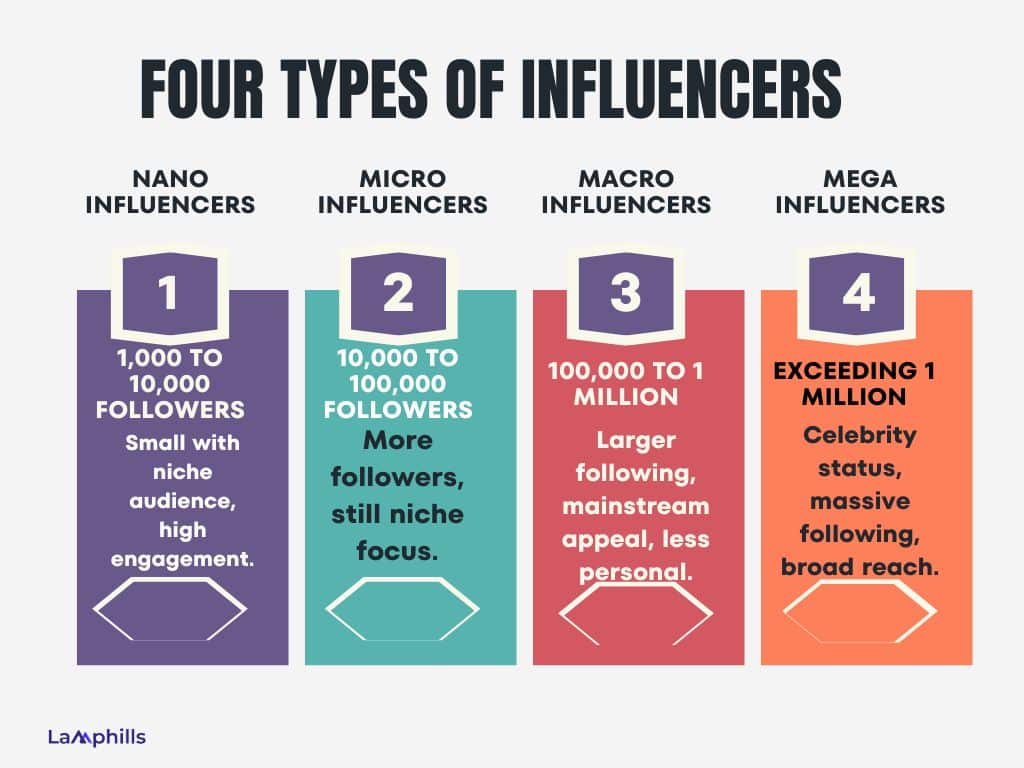
#1. Nano-Influencers
These people only have a small number of followers, but they tend to be experts in an obscure or highly specialized field. You can think of nano-influencers as being the proverbial big fish in a small pond.
Nano Influencers have between 1,000 and 10,000 followers. Regardless, these are keen and interested followers, willing to engage with the nano-influencer and listen to their opinions.
While many brands would consider nano-influencers to be inconsequential, they can be of extreme importance to firms that make highly specialized and niche products. For most firms, however, nano-influencers probably lack sufficient influence to be of much use. They may be cheap and carry tremendous sway with a small number of people, but in most niches, you would need to work with hundreds of nano-influencers to reach a broad audience.
#2. Micro-Influencers
Micro-influencers are ordinary people who have become known for their knowledge about some specialist niche. As such, they have gained a sizable social media following amongst devotees of that niche. Of course, it is not just the number of followers that indicates a level of influence; it is the relationship and interaction that a micro-influencer has with his or her followers.
Although views differ, you could consider micro-influencers as having between 10,000 and 100,000 followers on a single social platform.
Micro-influencers have built up specialist followings, and they will not want to harm their relationship with their fans if they are seen to promote a lemon. This requirement for the relationship between micro-influencers and brands to align with target audiences means that influencers are often picky about with whom they work. Some micro-influencers are happy to promote a brand for free. Others will expect some form of payment.
Regardless of the price, any influencer is unlikely to want involvement with an “inappropriate” brand for their audience.
Over 35% of influencers have been building an audience for over four years and 21% earn over $50k annually. However, the majority of creators identifying themselves on the internet today fall into the nano or micro tier. The majority of campaign power comes not from mega influencers with huge audiences, but actually from influencers with a smaller following, higher engagement, and developed relationships with their audience.
In all reality, micro-influencers are the influencers of the future.
#3. Macro-Influencers
Macro-influencers are one step up from micro-influencers and may be more accessible as influencer marketers. The number of their followers typically ranges between 100,000 and 1 million on a social network.
This group tends to consist of two types of people. They are either B-grade celebrities, who haven’t yet made it to the big time. Or they are successful online experts, who have built up more significant followings than the typical micro-influencers. The latter type of macro-influencer is likely to be more useful for firms engaging in influencer marketing.
Macro-influencers generally have a high profile and can be excellent at raising awareness. There are more macro-influencers than mega-influencers, so it should be easier for a brand to find a macro-influencer willing to work with them. They are also more likely to be used to working with brands than micro-influencers, making communication easier.
However, you do need to be careful with this level of influence. This is the category most likely to engage in influencer fraud – some have only reached their position thanks to the followers they have purchased.
#4. Mega-Influencers
Mega influencers are people with a vast number of followers on their social networks. Although there are no fixed rules on the boundaries between the different types of followers, a common view is that mega-influencers have more than 1 million followers on at least one social platform.
Many mega-influencers are celebrities who have gained their fame offline – movie stars, sportspeople, musicians, and even reality television stars. However, mega-influencers can also gain vast followings through their online and social activities.
Only major brands should approach mega-influencers for influencer marketing. Their services will be costly, and they will most likely be extremely fussy about with whom they choose to partner. In virtually every case, mega-influencers will have agents working on their behalf to make any marketing deals.
How To Find YouTube Influencers
To find YouTube influencers, you can try the following steps:
- Search for relevant keywords on YouTube and see who comes up in the results. Look for channels with a large number of subscribers and high engagement (likes, comments, and shares).
- Try searching on Google or other search engines, searching for keywords related to your industry and “YouTube influencer” or “YouTube channel”.
- Consider using social media to find influencers. Many influencers have a presence on multiple social media platforms, such as Instagram, TikTok, and Twitter. You can use these platforms to discover influencers and reach out to them about collaborations.
- Use YouTube influencer search tools to quickly find relevant YouTubers. For example, on Promoty, you can filter their global database of influencers by location, language, and other metrics. This way, you can quickly and precisely find the right influencers!
Below are 10 proven ways to help you find YouTube influencers:
How To Find YouTube Influencers
How To Reach Out To A YouTube Influencer
Building a relationship with a YouTube influencer is a two-way process. Just as you have criteria to find your perfect match, you also have to demonstrate to influencers why you’re worth their time.
When you begin to contact influencers, message them through their official channels or try to find a direct email. You should personalize your message for each influencer, explaining why you’re interested in collaborating with them specifically, how your brand aligns with theirs, and what you can offer.
Be professional and sincere but emphasize your unique selling points.
Keep in mind that high-profile influencers will receive many proposals for brand partnerships, so they may not reply immediately or at all. Don’t be discouraged, follow up when appropriate, and cast a wide net so your campaign isn’t dependent on one influencer only.
Here’s an example of an initial email to catch influencers’ attention:
Dear [influencer name],
I’m [your name], [position] at [company name], [brief description of company]. We’ve been following your content on YouTube and think that your influence and expertise align perfectly with our brand values and objectives.
We’d love to discuss collaborating with you. We’re currently promoting [product/service/campaign] and believe it speaks to your audience because [value proposition].
We have some ideas about what the partnership could look like, including [product reviews, tutorials, sponsored videos, giveaways, etc.]. In return, we can offer [budget, free products/services, exposure], as well as help to deliver even more value to your viewers.
Let us know if you’re interested in working together and we can discuss details.
Thanks,
How To Find YouTube Influencers: 5 Best Platforms
#1. Brandwatch Influencer Marketing Software
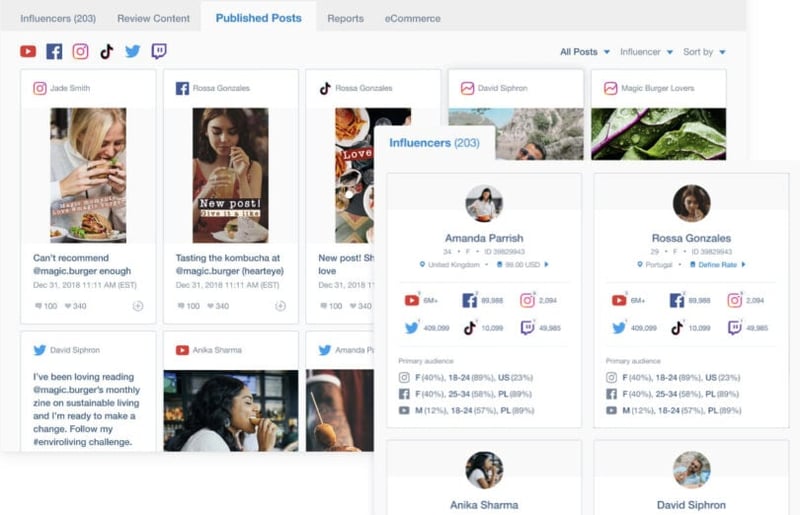
Brandwatch Influence is an end-to-end influencer marketing platform. It offers a massive database with more than 30 million influencer profiles across YouTube (as well as Instagram and TikTok). To help you find your way around this huge collection of YouTube influencers, use its powerful search features.
Using filters like platform, audience demographics, social followers, topics, engagement, country, and language, you can zoom in on the potential candidates that will match your brand, target market, and campaign goals the best.
Key Features:
- Influencer discovery and vetting
- Performance tracking and reporting
- Workflow management
- Social media management
- AI-powered consumer intelligence
- Market research
- Customer care
Pricing:
Customized. Sign up on the agency’s form to schedule a meeting. (Starts at $750/month)
#2. Upfluence
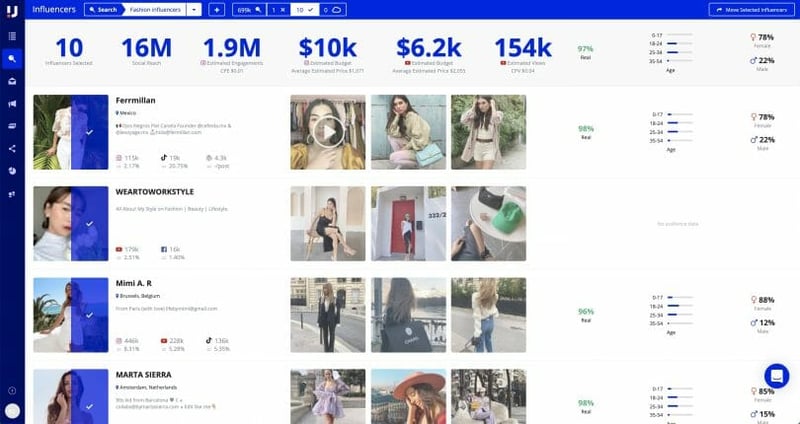
Upfluence hosts a database of over 1 million influencers across multiple social networks. It’s one of the best platforms to find YouTube influencers because it highlights creators who already love your brand. This matters a lot since data shows these influencers are seven times more likely to collaborate with you. The platform also finds influencers who genuinely match your brand’s style and message based on their data, content, and performance.
Plus, it offers detailed tracking to help you make smarter decisions using its data-rich influencer profiles.
Key Features:
- ChatGPT assistant
- Influencer analysis, matching, communication, gifting, tracking, and payment
- Campaign analytics
- Workflow management
- Budget and ROI tracking
Pricing:
Growth (one seat or user), Scale (5 seats), and Enterprise (25 seats) plans are available. However, you must book a meeting with the agency to get a quote. (A monthly fee starts at $478 per month.)
#3. Creator.co
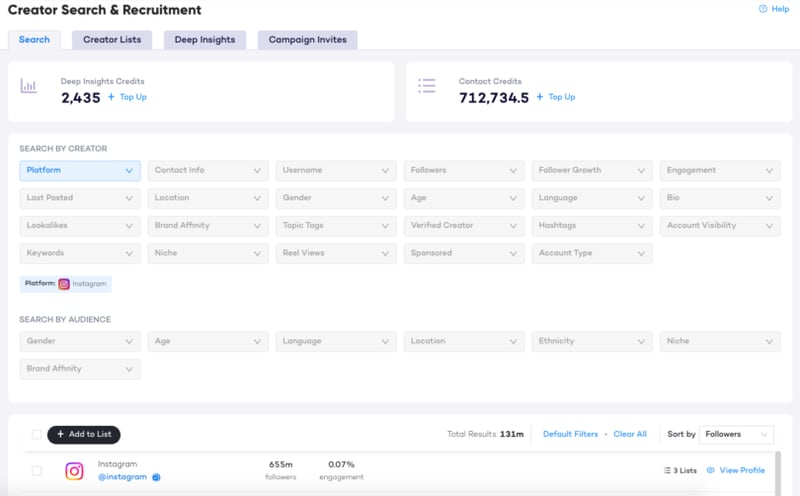
Creator.co is a Vancouver-based influencer marketing platform that focuses on YouTube, Instagram, and TikTok creators. Brands love Creator.co because it’s got top-notch influencer search and insights. Its database covers over 300 million profiles from YouTube, TikTok, and Instagram, and its advanced analytics make finding and recruiting influencers easy. Plus, Creator.co helps you run big influence and affiliate campaigns smoothly.
Everything from managing creators, campaigns, content, payments, and analytics is all done in one easy-to-use dashboard. You will also have an account manager to help you develop strategies, recruit creators, and keep track of KPIs.
Key Features:
- Influencer search, recruitment, and analytics
- Affiliate program management
- Campaign and influencer payment management
- Social media content and ad management
- Collaboration hub
Pricing:
Creator.co offers four subscription plans: Self-Serve, Start-up, Trailblazer, and Bespoke, which range from $460/month to over $3,000/month. As you upgrade to a higher plan, you will gain access to more advanced automated features. They also offer 15% savings on full-year payments. You must subscribe for at least three months and pay a one-time $395 onboarding fee.
Three agency plans (Boutique, Power House, and Global) are also available, starting at $7,495+ per year.
#4. LTK (formerly rewardStyle)

LTK, based in Texas, is a global tech platform that helps lifestyle creators and influencers become top-tier brand partners. With over 13 years of exclusive sales data and performance metrics across different channels, LTK stands out in crafting influencer marketing campaigns for brands of any scale. They offer a range of products and services, from self-service to full-service, with proven ROI and comprehensive brand performance tracking.
LTK is known for its Brand Platform, which harnesses creator-powered marketing to grow its client’s businesses. Access to the platform helps clients put together the best-curated creators and reach the right audience on the proper platforms, courtesy of their advanced audience reporting.
Key Features:
- LTK Marketplace
- Retail media networks
- Insights via LTK Benchmark
- Content licensing
- LTK Shops
- White label services
Pricing:
With LTK Connect, brands can connect directly with LTK’s creators and shoppers. They can subscribe to any of these three plans: Connect Launch, Connect Pro, and Connect Sale. The starter cost is $417 per month, paid as one annual fee of $5,000.
#5. Skeepers
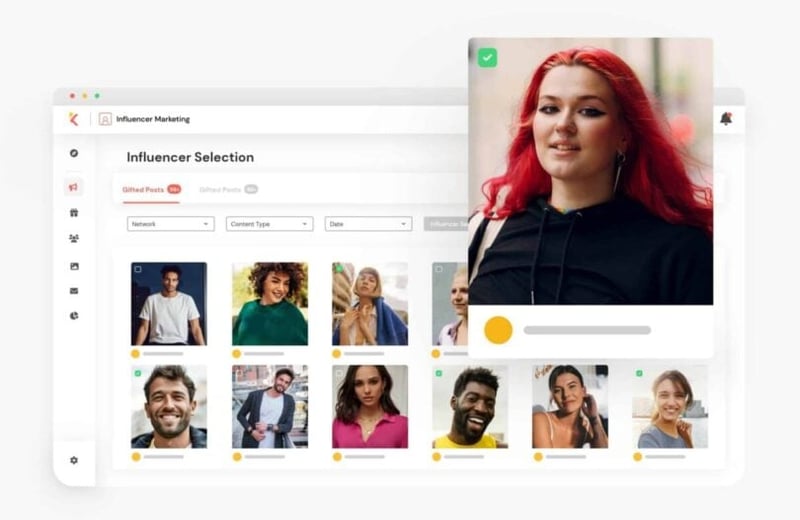
Skeepers is an influencer marketing platform primarily centered around YouTube, with additional capabilities for TikTok and Instagram. It’s a SaaS-based solution that covers all aspects of user-generated content (UGC), making it a convenient one-stop shop for shopper engagement. Unlike any other company, Skeepers allows brands to utilize every form of UGC, from creation and collection to management and activation.
With innovative, AI-based solutions, Skeepers ensures that both brands and consumers enjoy trusted and authentic experiences.
Key Features:
- Real-time campaign performance monitoring and reporting
- Customer data activation (online or offline client/purchase data analysis)
- Live shopping
- Review collection and management
Pricing:
Rates are upon request. You may reach them by completing the sign-up form on their Influencer Marketing page.
What Makes A Good YouTube Influencer?
With 250 million subscribers, MrBeast might be the most popular influencer in the world, but does his core audience align with your brand objectives? And will your budget stretch far enough to work with him?
Don’t dive in and start contacting people right away. Like any element of your marketing strategy, finding the right YouTube influencer requires research.
First, you need to ensure that your influencer has the audience size and reach that you’re looking for. They also need to have a voice that aligns with your brand and messaging, as well as a price that matches your budget. Once you’ve checked those basic characteristics, delve deeper into their previous content and online presence.
It’s also worthwhile asking yourself a few questions before you reach out to influencers.
- Is there a clear connection between the influencer’s content and my product/service?
- What problems/pain points does the influencer’s audience have that my product/service could solve?
- What values does my brand share with the influencer?
- What would motivate the influencer to collaborate with my brand?
- Would my target audience listen to and trust this influencer? Why?
Pay attention to the number of views they get per post, the average number of likes, and links to any other social profiles they may have. You can do this manually or by leveraging influencer marketing tools like Semrush’s Influencer Analytics.
Why Use YouTube Influencers?
There are more than two billion active users on YouTube; that’s a huge pool of people to potentially build brand relationships with. And, because of its scope and popularity, YouTube is the second most preferred platform for influencer marketing.
However, it’s not just the size of YouTube that makes it such a powerful tool for influencer marketing. Google research shows that influencers on the platform have the same power to guide people’s purchase decisions as celebrities.
So, rather than trying to leverage famous names, brands can tap into the same persuasion through an array of influencers.
YouTube influencer videos can take many formats but a few popular examples are:
- Unboxing (an influencer opens and uses a product/service for the first time)
- Product reviews (an influencer provides an honest opinion of a product/service)
- Contests (influencers provide brand products/services as prizes in their content)
- Hauls (an influencer who rates products and services from different brands)
- Tutorials (products/services appear in steps for influencers’ explainer content)
- Day-in-the-life-of (products and services featured in influencer videos of their daily routines)
Video content always resonates well with audiences. It’s accessible, interactive, and humanizing. In modern marketing, audiences want brands that represent real people, and so by working with YouTube influencers, you demonstrate that you have value, vouched for by influencers they recognize.
Recommended Articles
- Proven SaaS Content Marketing Tactics for Boosting Engagement and Conversions
- How to Create Promotional Content That Drives Results for Your Brand(Plus Examples)
- Branded Content Marketing: The Powerful Strategy Big Brands Don’t Want You to Know
- A Step-by-Step Guide to Building a Comprehensive LinkedIn Content Strategy
- The 5 Best Content Writing Services for Skyrocketing Growth in 2024
- How to Be a Content Creator That Brands Are Desperate to Hire
